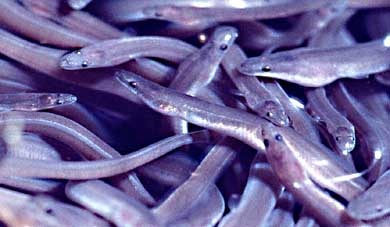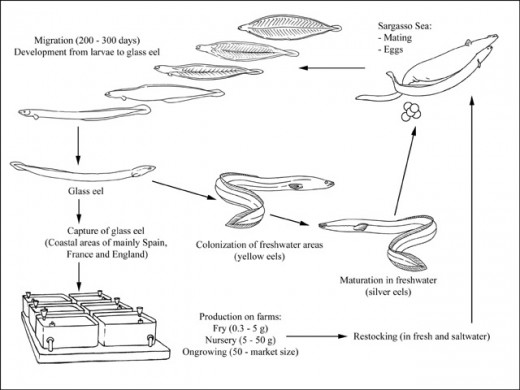Glass Eels: Little Eels Worth Big Money!
America is the land of plenty. We have plenty of food, there are also plenty of food choices. Back in the 1975 the average American supermarket had nearly 9,000 different items that you could choose to purchase. After all, the number of choices is why it’s called a “Super” market. By 2008, American tastes had driven the number of choices to over 46,000. America loves having choices. But that doesn’t mean that if something is popular somewhere else in the world that Americans will be interested in it. Take, for example, a delicacy that is prized in Europe, eels. Unless you like sushi, American’s rarely eat eels. Yet Eels are still becoming big business in the US. Let’s learn a bit about eels, and what they mean to our economy and the environment!

What's the Issue?
Eels are long, thin, fin-less fish. They are true fish, but they resemble snakes more than fish. There are over 800 species of eels, some of which are found in the sea and some of which live in freshwater. The world largest market for eels is Japan, which consumes over 70% of the eels caught world-wide. Eel are not only caught in the wild, but for centuries have been commercially farmed. As with many other species, eels have been so overfished that more and more of the world’s catch is coming from aquaculture rather than nature.
Since Japan is the world’s largest market for eels, it’s not surprising that it is the Japanese eel that is under the greatest pressure from over-fishing. For years, the Japanese have looked for ways to increase the number eels to match the demand. First it was aquaculture. Since the 1950’s, Japan has increasingly turned to aquaculture to make up for the growth in demand. Until the last few years, Japan… with a bit of help from eel farms… had plenty of eels. But then a few other things happened.
The expanding demand for eels from other Asian countries (especially China) led to increasing pressure on European eels, which were the substitute eels of choice in Japan. However, the 1970’s the European eel has been in decline since 1970, mostly from over-fishing. Then, the native Japanese eel was declare endangered. At the same time, Japan’s big tsunami in 2011, the one that destroyed the Fukushima Daiichi nuclear power station, has raised questions about the radiation level of local seafood, including eels.
What are your priorities?
What is the best way to protect endangered species?
Eel Farming

Finding New Sources:
All of these issues have intensified the search for a new source of eels. Today, the hot item is Asia is the American eel. Very similar in size, shape and taste to the Japanese eel, is rapidly became the replacement of choice. As other eel sources became protected, exhausted or tainted with the possibility of irradiation from Fukushima, the American eel became the overnight eel of choice. Like many other fish that are currently endangered, and may next face extinction, the growing demand for the eels that remain are distorting the price, driving it to new heights.
In 2002, a kilogram of eel in Japan cost about 1,000 Yen, but by 2013 the cost rose to nearly $4,000 yen. But the real price escalation has been happening with the baby eels that are needed for aquaculture. These baby eels, called glass eels or elvers, are found and fished in New England, especially in Maine.
Glass eels were once consumed as a cheap food, but now are far more valuable to eel farmers in China. In 2001, a pound of glass eels cost just $24.14. In 2005 the price rose to $346.66. In 2012 the price hit its highest price ever, at over $2,000 a pound. Needless to say, poaching in Maine has become rampant. Little eels turn into big gold in Maine these days! Eel fishers in Maine may bring in $100,000 in a single night.

An Industry in Eels?
But that was just the start. Even at these highly inflated prices, each glass eel costs the farmer around $1 each. That eel, is then grown to a sellable size, 3 pound or more. These eels are then sold at $8 to $12 per pound. As expensive as glass eels have become, the same eels are worth 30 times when they leave China as when they arrive. Today the US glass eel market is small, just $40 million a year. But that market is driving over a billion dollars in world-wide sales.
If Japan is to have enough eel for their next summer festivals, much more conservation is needed. Just as the European and Japanese eels have been overfished, the American eel is going to be next. Eel fishing in New England is regulated, but the sky-high prices for baby eels has started a rising tide of poaching that is only going to get worse over time.
Japan will continue to demand the majority of the year’s catch. And China is becoming a growing customer for eels, and a competitor to Japan. For the short run at least, the price will continue to rise and the availability of eels will fall. Before the average American even become aware that there is a domestic market in eels, they may already be gone.
The Eel Harvest
While people have been eating eels since the beginning of time, we know very little about them. We know that during their lives they go from rivers, to lakes, to the oceans, and back again. We also know that if we don’t do something soon, their own popularity will drive them into extinction soon, perhaps even sooner than their European and Japanese cousins.
We need to find ways to protect the species we have. Not just to protect an emerging industry, but to make sure that we leave something for the next generation. Eels are not at the top of America’s environmental issue list, but we have more control over this issue than most. This is our golden opportunity to help fix the oceans. We just need to decide if we want the gold more than we want the eels. At least, that’s my Niccolls worth.






